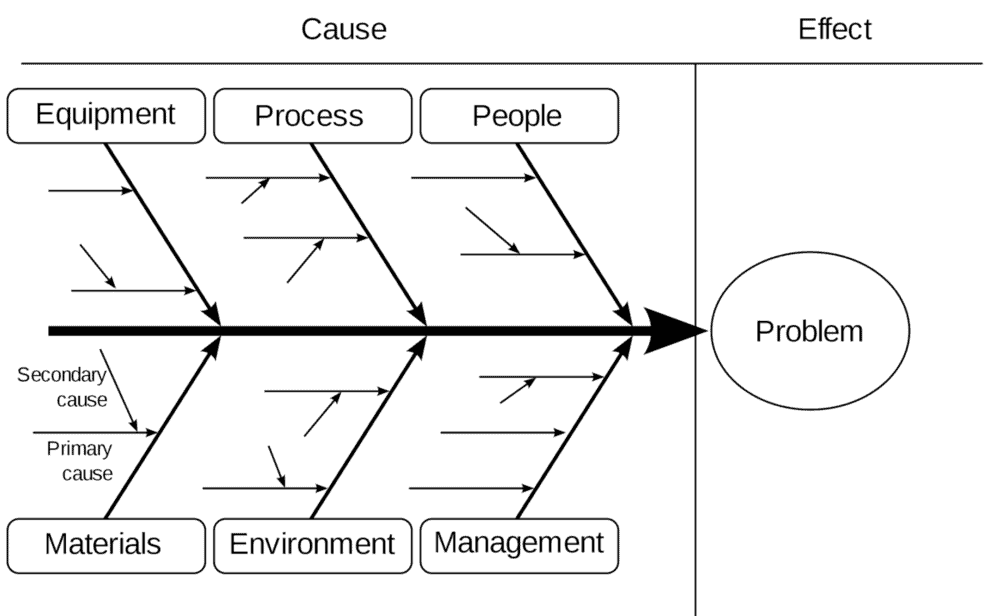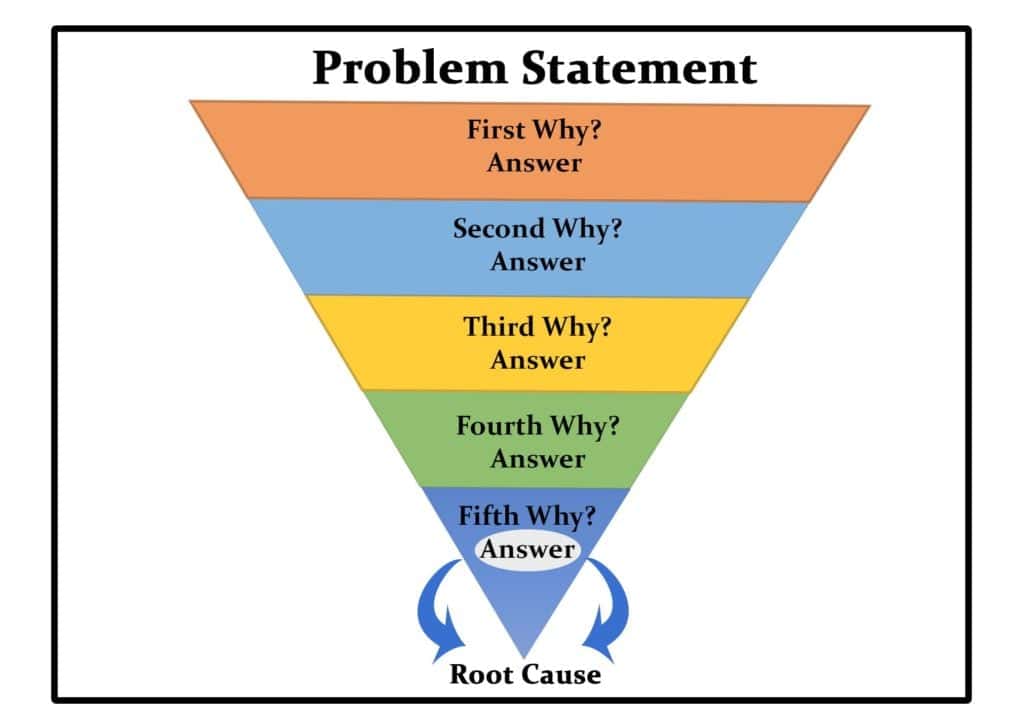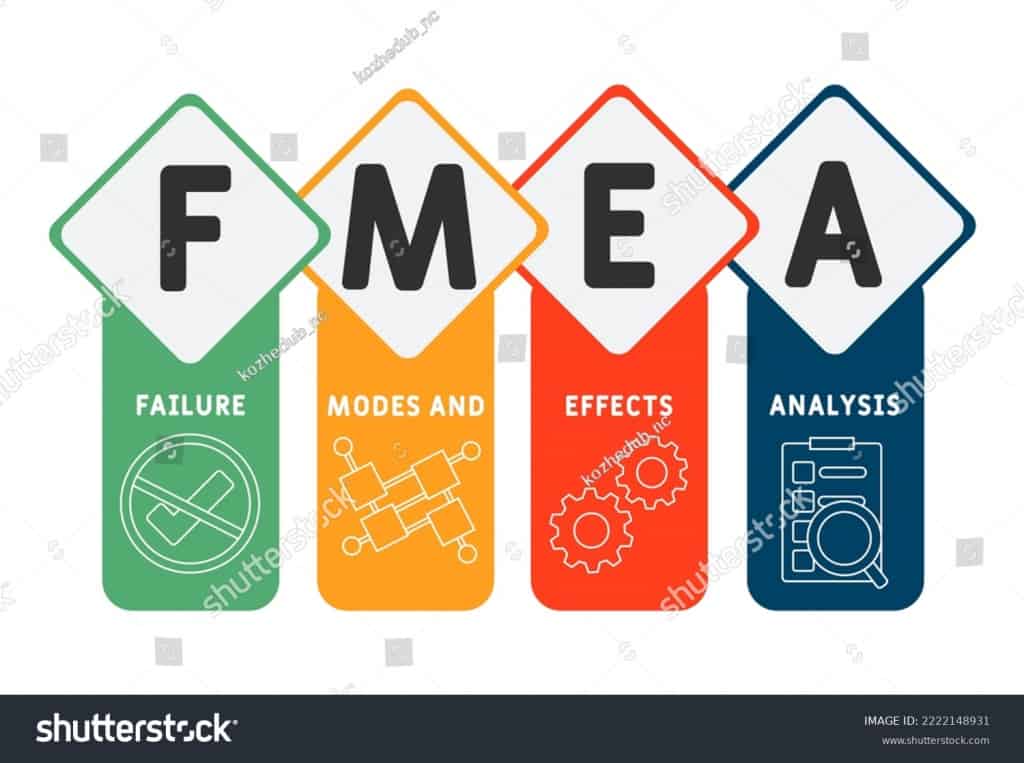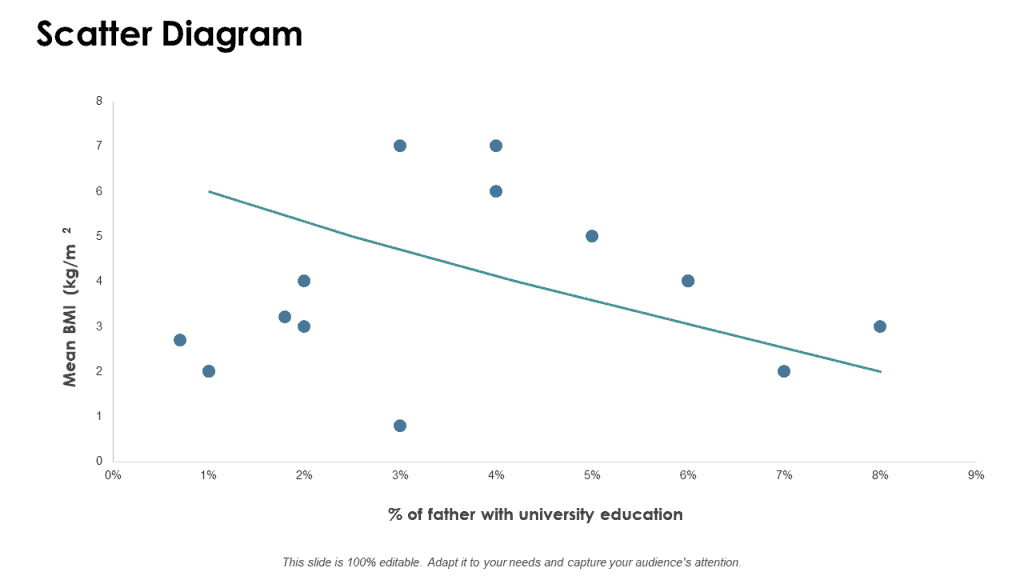在不斷變化的組織世界中,找出並處理挑戰的主要原因對於長期發展至關重要。 根本原因分析方法 (RCA) 是一種結構化方法,它超越了解決症狀的目的,旨在揭示導致問題的真正問題。 透過使用 RCA,組織可以提高解決問題的能力、提高流程效率並培養持續改進的文化。
在這篇文章中,我們將探討根本原因分析方法到底是什麼、它的好處以及 5 個核心 RCA 工具。
目錄
什麼是根本原因分析方法?

根本原因分析方法是一種結構化和有組織的方法,用於識別和解決組織內的問題。
這種方法也稱為“根本原因分析”,它使用特定的技術來尋找問題的根本原因。它超越表面症狀,直擊問題的根源。透過這種方法,組織可以識別導致問題的核心因素,並制定有效的解決方案。
這種方法是更廣泛方法的一部分,強調理解和減輕根本原因,以防止問題再次出現並促進持續改進。
根本原因分析的好處
- 問題預防: 根本原因分析方法有助於識別問題的根本原因,使組織能夠實施預防措施。 透過解決根本原因,組織可以主動防止問題再次出現,從而減少未來挑戰的可能性。
- 改進決策: 根本原因分析方法可以更深入地了解導致問題的因素,從而做出明智的決策。 組織可以透過考慮根本原因來做出更具策略性和更有效的決策,從而實現更好的資源分配和長期解決方案。
- 增強解決問題的能力: RCA 的系統化方法旨在培養團隊強大的解決問題能力。它鼓勵透徹的分析,高效應對挑戰,並培育持續改進的文化。
- 高效率的流程優化: 使用根本原因分析法 (Root Cause Analysis Method) 找出根本原因,可以簡化操作。由於團隊專注於解決工作流程中的核心問題,從而提高效率、減少浪費並提升生產力。
5 根本原因分析工具
為了有效地實施根本原因分析法,需要使用各種工具來系統性地調查和了解導致問題的因素。本文,我們將探討根本原因分析法中廣泛使用的五種基本工具。
1/ 魚骨圖(石川圖或因果圖):

魚骨圖或根本原因分析魚骨法是一種視覺表示形式,有助於對問題的潛在原因進行分類和探索。
它的結構類似魚的骨骼,「骨頭」代表不同的類別,例如人員、流程、設備、環境等等。該工具鼓勵全面檢查各種因素,以找出根本原因,從而提供問題全貌的全面視圖。
這個過程涉及協作腦力激盪會議,團隊成員在每個類別下貢獻可能的原因。 透過直觀地組織這些輸入,團隊可以深入了解不同因素之間的相互關聯,從而促進更有針對性的根本原因分析方法。
2/ 5 為什麼:

根本原因分析的 5 個為什麼方法是一種簡單但強大的提問技巧,它鼓勵團隊反覆詢問“為什麼”,直到發現問題的根本原因。
此工具深入探究因果關係的各個層面,促進對當前問題的徹底探索。 提問的迭代性質有助於消除表面症狀,揭示導致問題的潛在因素。
根本原因分析的「5 個為什麼」方法因其簡單性和可訪問性而有效,使其成為快速解決問題和識別根本原因的寶貴工具。 它鼓勵持續的探索過程,超越最初的反應,並深入問題的核心。
3/帕累托分析:

帕累托分析,基於 帕累托原理,是一種透過專注於重要的少數而不是瑣碎的多數來幫助確定問題優先順序的工具。 該原理表明,大約 80% 的影響來自 20% 的原因。 就 RCA 而言,這意味著將精力集中在對問題影響最大的少數重要因素。
透過應用帕累托分析,團隊可以識別對解決問題產生最大影響的關鍵根本原因,並確定其工作的優先順序。 當資源有限時,該工具特別有用,可確保採取有針對性且高效的 RCA 方法。
4/ 失效模式與影響分析(FMEA):

常用於製造和工程, 失效模式與影響分析(FMEA) 是一種識別過程中潛在故障模式並確定優先順序的系統方法。 FMEA 評估潛在故障的嚴重性、發生率和偵測情況,並為每個標準分配分數。
FMEA 是一種幫助團隊優先關注風險最高領域的方法。 透過分析潛在影響、發生的可能性以及檢測故障的能力,團隊可以確定哪些領域最需要關注。 這使得團隊能夠有效地分配資源並在潛在問題成為問題之前解決它們。
5/散點圖:

散點圖是根本原因分析中使用的視覺化工具,用於探索兩個變數之間的關係。
透過在圖表上繪製數據點,它可以揭示模式、相關性或趨勢,幫助識別因素之間的潛在聯繫。 此圖提供了一種快速、簡單的方法來理解資料集中的關係。
無論是評估因果動態還是識別潛在的影響因素,散點圖對於理解變數的相互作用和指導策略決策以在不同的組織環境中有效解決問題都非常有價值。
這些工具共同構成了一個強大的工具包,可供尋求有效實施根本原因分析的組織使用。 無論是使用魚骨圖來視覺化複雜關係,深入探討5 個為什麼,使用帕累托分析來確定工作優先級,還是使用FMEA 預測故障,每個工具在系統識別和解決根本問題方面都發揮著獨特的作用,促進內部持續改善的文化該組織。
關鍵要點
對於旨在有效應對挑戰的組織來說,實施根本原因分析方法至關重要。 採用結構化方法,例如腦力激盪會議和分類,可確保對根本問題進行徹底檢查。
為了擴大這些努力,使用 AhaSlides 進行會議和腦力激盪會議將成為改變遊戲規則的舉措。 啊哈幻燈片 促進即時協作,提供動態腦力激盪和集體解決問題的互動式工具。透過利用 AhaSlides,組織不僅可以簡化其根本原因分析流程,還可以創造一個參與和創新的環境。
常見問題
根本原因分析的 5 個步驟是什麼?
- 定義問題:清楚表達需要分析的問題或議題。
- 收集資料:彙編與問題相關的資料。
- 確定可能的原因:集思廣益,列出潛在原因的清單。
- 評估原因:分析已確定的原因,衡量其重要性和與問題的相關性。
- 實施解決方案:根據已確定的根本原因,制定並執行糾正措施。監控結果以確保持續改善。
什麼是「5個為什麼」方法?
5個為什麼是根本原因分析中使用的一種提問技巧,用於迭代探索問題背後的因果關係。這個過程需要反覆詢問“為什麼”,通常需要問五遍,以揭示更深層的因果關係,直到找到根本原因。








